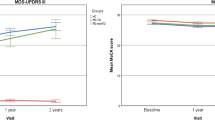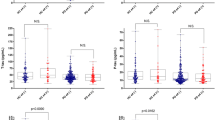Abstract
Parkinson’s disease (PD) is a neurodegenerative disorder with highly heterogeneous clinical manifestations. This fact has prompted many attempts to divide PD patients into clinical subgroups. This could lead to a better recognition of pathogenesis, improving targeted treatment and the prognosis of PD patients. The aim of the present study was to obtain cerebrospinal fluid (CSF) samples in PD patients and to search for a relationship between neurodegenerative CSF markers (tau protein, beta-amyloid1-42 and index tau protein/beta-amyloid1-42) and the clinical subtypes. PD patients were divided into three subgroups: early disease onset (EDO), tremor-dominant PD (TD-PD), and non-tremor dominant PD (NT-PD) according to the previously published classification. Neurodegenerative markers in the CSF were assessed in these three groups of patients suffering from PD (EDO-17, TD-15, NT-16 patients) and in a control group (CG) of 19 patients suffering from non-degenerative neurological diseases and 18 patients with Alzheimer’s disease (AD). The NT-PD patients were found to have significantly higher levels of CSF tau protein and index tau/beta than the control subjects and other Parkinsonian subgroups, but no significant differences in these markers were found between AD and NT-PD patients. In the context of more rapid clinical progression and more pronounced neuropathological changes in the NT-PD patient group, our results corroborate the opinion that CSF level of tau protein may be regarded as a potential laboratory marker of the presence and severity of neurodegeneration.







Similar content being viewed by others
References
Alves G, Brønnick K, Aarsland D, Blennow K, Zetterberg H, Ballard C et al (2010) CSF amyloid-{beta} and tau proteins, and cognitive performance, in early and untreated Parkinson’s Disease: the Norwegian ParkWest study. J Neurol Neurosurg Psychiatry 81:1080–1086
Arima K, Hirai S, Sunohara N, Aoto K, Izumiyama Y, Ueda K et al (1999) Cellular co-localization of phosphorylated tau- and NACP/alpha-synuclein-epitopes in Lewy bodies in sporadic Parkinson’s disease and in dementia with Lewy bodies. Brain Res 843:53–61
Bibl M, Mollenhauer B, Esselmann H, Lewczuk P, Klafki HW, Sparbier K et al (2006) CSF amyloid-beta-peptides in Alzheimer’s disease, dementia with Lewy bodies and Parkinson’s disease dementia. Brain 129:1177–1187
Blennow K, Nellgĺrd B (2004) Amyloid beta 1-42 and tau in cerebrospinal fluid after severe traumatic brain injury. Neurology 62(1):159–160
Burn DJ, Rowan EN, Allan LM, Molloy S, O’Brien JT, McKeith IG (2006) Motor subtype and cognitive decline in Parkinson’s disease with dementia, and dementia with Lewy bodies. J Neurol Neurosurg Psychiatry 77:585–589
Buter TC, van den Hout A, Matthews FE, Larsen JP, Brayne C, Aarsland D (2008) Dementia and survival in Parkinson’s disease. Neurology 70:1017–1022
Clinton LK, Blurton-Jones M, Myczek K, Trojanowski JQ, LaFerla FM (2010) Synergistic Interactions between Abeta, tau, and alpha-synuclein: acceleration of neuropathology and cognitive decline. J Neurosci 30:7281–7289
Compta Y, Martí MJ, Ibarretxe-Bilbao N, Junqué C, Valldeoriola F, Muñoz E et al (2009) Cerebrospinal tau, phospho-tau, and beta-amyloid and neuropsychological functions in Parkinson’s disease. Mov Disord 24:2203–2210
Esposito A, Dohm CP, Kermer P, Bähr M, Wouters FS (2007) Alpha-Synuclein and its disease-related mutants interact differentially with the microtubule protein tau and associate with the actin cytoskeleton. Neurobiol Dis 26:521–531
Fagan AM, Roe CM, Xiong C, Mintun MA, Morris JC, Holtzman DM et al (2007) Cerebrospinal fluid tau/beta-amyloid(42) ratio as a prediction of cognitive decline in nondemented older adults. Arch Neurol 64:343–349
Goel V, Grafman J (1995) Are the frontal lobes implicated in `planning’ functions? Interpreting data from the Tower of Hanoi. Neuropsychologia 33:623–642
Graham JM, Sagar HJ (1999) A data-driven approach to the study of heterogeneity in idiopathic Parkinson’s disease: identification of three distinct subtypes. Mov Disord 14:10–20
Hoehn MM, Yahr MD (1967) Parkinsonism: onset, progression and mortality. Neurology 17(5):427–442
Hu WT, Chen-Plotkin A, Arnold SE, Grossman M, Clark CM, Shaw LM et al (2010) Biomarker discovery for Alzheimer’s disease, frontotemporal lobar degeneration, and Parkinson’s disease. Acta Neuropathol 120(3):385–399
Hughes AJ, Daniel SE, Kilford L, Lees AJ (1992) Accuracy of clinical diagnosis of idiopathic Parkinson’s disease: a clinico-pathological study of 100 cases. J Neurol Neurosurg Psychiatry 55:181–184
Jellinger KA (2008) Neuropathological aspects of Alzheimer disease, Parkinson disease and frontotemporal dementia. Neurodegener Dis 5:118–121
Jellinger KA (2009) A critical evaluation of current staging of alpha-synuclein pathology in Lewy body disorders. Biochim Biophys Acta 1792:730–740
Jellinger KA, Seppi K, Wenning GK, Poewe W (2002) Impact of coexistent Alzheimer pathology on the natural history of Parkinson’s disease. J Neural Transm 109:329–339
Lashley T, Holton JL, Gray E, Kirkham K, O’Sullivan SS, Hilbig A et al (2008) Cortical alpha-synuclein load is associated with amyloid-beta plaque burden in a subset of Parkinson’s disease patients. Acta Neuropathol 115:417–425
Lee VM, Goedert M, Trojanowski JQ (2001) Neurodegenerative tauopathies. Annu Rev Neurosci 24:1121–1159
Lewis SJ, Foltynie T, Blackwell AD, Robbins TW, Owen AM, Barker RA (2005) Heterogeneity of Parkinson’s disease in the early clinical stages using a data driven approach. J Neurol Neurosurg Psychiatry 76:343–348
Lyros E, Messinis L, Papathanasopoulos P (2008) Does motor subtype influence neurocognitive performance in Parkinson’s disease without dementia? Eur J Neurol 15:262–267
Mattila PM, Koskela T, Röyttä M, Lehtimäki T, Pirttilä TA, Ilveskoski E et al (1998) Apolipoprotein E epsilon4 allele frequency is increased in Parkinson's disease only with co-existing Alzheimer pathology. Acta Neuropathol 96(4):417–420
Mattsson N, Zetterberg H, Hansson O, Andreasen N, Parnetti L, Jonsson M et al (2009) CSF biomarkers and incipient Alzheimer disease in patients with mild cognitive impairment. JAMA 302(4):385–393
Mollenhauer B, Trenkwalder C, von Ahsen N, Bibl M, Steinacker P, Brechlin P et al (2006) Beta-amyloid 1–42 and tau-protein in cerebrospinal fluid of patients with Parkinson’s disease dementia. Dement Geriatr Cogn Disord 22:200–208
Obereigneru R, Obereigneru K, Cakirpaloglu S, Reiterova E, Kanovsky P (2010) Tower of Hanoi and the new administration rules for effective executive functions diagnostics. Eur J Neurol 17(Suppl 3):482
Okonkwo OC, Alosco ML, Griffith HR, Mielke MM, Shaw LM, Trojanowski JQ et al (2010) Cerebrospinal fluid abnormalities and rate of decline in everyday function across the dementia spectrum: normal aging, mild cognitive impairment, and Alzheimer disease. Arch Neurol 67:688–696
Ost M, Nylén K, Csajbok L, Ohrfelt AO, Tullberg M, Wikkelsö C et al (2006) Initial CSF total tau correlates with 1-year outcome in patients with traumatic brain injury. Neurology 67(9):1600–1604
Pan S, Shi M, Jin J, Albin RL, Lieberman A, Gearing M et al (2007) Proteomics identification of proteins in human cortex using multidimensional separations and MALDI tandem mass spectrometer. Mol Cell Proteomics 6(10):1818–1823
Paulus W, Jellinger K (1991) The neuropathological basis of different clinical subgroups of Parkinson’s disease. J Neuropathol Exp Neurol 50:743–755
Přikrylová Vranová H, Mareš J, Nevrlý M, Zapletalová J, Hluštík P, Kaňovský P (2010) CSF markers of neurodegeneration in Parkinson’s disease. J Neural Transm 117:1177–1181
Qureshi HY, Paudel HK (2011) Parkinsonian neurotoxin MPTP and alpha-synuclein mutations promote tau protein phosphorylation at Ser262 and destabilize microtubule cytoskeleton in vitro. J Biol Chem 286(7):5055–5068
Rajput A, Dickson DW, Robinson CA, Ross OA, Dächsel JC, Lincoln SJ et al (2006) Parkinsonism, Lrrk2 G2019S, and tau neuropathology. Neurology 67:1506–1508
Rajput AH, Voll A, Rajput ML, Robinson CA, Rajput A (2009) Course in Parkinson disease subtypes: a 39-year clinicopathologic study. Neurology 73:206–212
Selikhova M, Williams DR, Kempster PA, Holton JL, Revesz T, Lees AJ (2009) A clinico-pathological study of subtypes in Parkinson’s disease. Brain 132:2947–2957
Selkoe DJ (2004) Cell biology of protein misfolding: the examples of Alzheimer’s and Parkinson’s diseases. Nat Cell Biol 6(11):1054–1061
Siderowf A, Xie SX, Hurtig H, Weintraub D, Duda J, Chen-Plotkin A et al (2010) CSF amyloid {beta}1-42 predicts cognitive decline in Parkinson disease. Neurology 75(12):1055–1061
Spreen O, Strauss E (1998) A compendium of neuropsychological tests, 2nd edn. Oxford University Press, New York
Stejskal D, Vavroušková J, Mareš J, Urbánek K (2005) Application of new laboratory marker assays in neurological diagnosis—a pilot study. Biomed Pap 149:265–267
Sunderland T, Linker G, Mirza N, Putnam KT, Friedman DL, Kimmel LH et al (2003) Decreased beta-amyloid1-42 and increased tau levels in cerebrospinal fluid of patients with Alzheimer disease. JAMA 289(16):2094–2103
van Rooden SM, Heiser WJ, Kok JN, Verbaan D, van Hilten JJ, Marinus J (2010) The identification of Parkinson’s disease subtypes using cluster analysis: a systematic review. Mov Disord 25(8):969–978
van Rooden SM, Colas F, Martínez-Martín P, Visser M, Verbaan D, Marinus J et al (2011) Clinical subtypes of Parkinson’s disease. Mov Disord 26(1):51–58
Waxman EA, Giasson BI (2011) Induction of intracellular tau aggregation is promoted by α-synuclein seeds and provides novel insights into the hyperphosphorylation of tau. J Neurosci 31(21):7604–7618
Williams DR, Lees AJ (2009) How do patients with parkinsonism present? A clinicopathological study. Intern Med J 39(1):7–12
Yao C, Williams AJ, Ottens AK, May Lu XC, Chen R et al (2008) Detection of protein biomarkers using high-throughput immunoblotting following focal ischemic or penetrating ballistic-like brain injuries in rats. Brain Inj 22(10):723–732
Acknowledgments
The study was supported by grant IGA MHCZ NT1222-5/2010.
Conflict of interest
The authors declare that they have no conflicts of interest.
Author information
Authors and Affiliations
Corresponding author
Rights and permissions
About this article
Cite this article
Přikrylová Vranová, H., Mareš, J., Hluštík, P. et al. Tau protein and beta-amyloid1-42 CSF levels in different phenotypes of Parkinson’s disease. J Neural Transm 119, 353–362 (2012). https://doi.org/10.1007/s00702-011-0708-4
Received:
Accepted:
Published:
Issue Date:
DOI: https://doi.org/10.1007/s00702-011-0708-4




